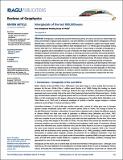Por favor, use este identificador para citar o enlazar a este item:
http://hdl.handle.net/10261/168880COMPARTIR / EXPORTAR:
 SHARE SHARE
 CORE
BASE CORE
BASE
|
|
| Visualizar otros formatos: MARC | Dublin Core | RDF | ORE | MODS | METS | DIDL | DATACITE | |

| Campo DC | Valor | Lengua/Idioma |
|---|---|---|
| dc.contributor.author | Berger, B. | es_ES |
| dc.contributor.author | Grimalt, Joan O. | es_ES |
| dc.contributor.author | Martrat, Belen | es_ES |
| dc.contributor.author | Vázquez Riveiros, Natalia | es_ES |
| dc.date.accessioned | 2018-08-20T08:58:31Z | - |
| dc.date.available | 2018-08-20T08:58:31Z | - |
| dc.date.issued | 2016-03 | - |
| dc.identifier.citation | Reviews of Geophysics 54 (1) 2016:162-219 | es_ES |
| dc.identifier.uri | http://hdl.handle.net/10261/168880 | - |
| dc.description.abstract | Interglacials, including the present (Holocene) period, are warm, low land ice extent (high sea level), end-members of glacial cycles. Based on a sea level definition, we identify eleven interglacials in the last 800,000 years, a result that is robust to alternative definitions. Data compilations suggest that despite spatial heterogeneity, Marine Isotope Stages (MIS) 5e (last interglacial) and 11c (∼400 ka ago) were globally strong (warm), while MIS 13a (∼500 ka ago) was cool at many locations. A step change in strength of interglacials at 450 ka is apparent only in atmospheric CO2 and in Antarctic and deep ocean temperature. The onset of an interglacial (glacial termination) seems to require a reducing precession parameter (increasing Northern Hemisphere summer insolation), but this condition alone is insufficient. Terminations involve rapid, nonlinear, reactions of ice volume, CO2, and temperature to external astronomical forcing. The precise timing of events may be modulated by millennial-scale climate change that can lead to a contrasting timing of maximum interglacial intensity in each hemisphere. A variety of temporal trends is observed, such that maxima in the main records are observed either early or late in different interglacials. The end of an interglacial (glacial inception) is a slower process involving a global sequence of changes. Interglacials have been typically 10-30 ka long. The combination of minimal reduction in northern summer insolation over the next few orbital cycles, owing to low eccentricity, and high atmospheric greenhouse gas concentrations implies that the next glacial inception is many tens of millennia in the future. ©2015. The Authors. | es_ES |
| dc.description.sponsorship | This paper arose as a result of a succession of workshops of the Past Interglacials Group (PIGS), sponsored by the Past Global Changes Project (PAGES). The authors acknowledge the contributions of all participants at those workshops, of whom the listed authors are only a subset. Numerous funding agencies have contributed to the work of this paper including NSF (USA), NERC and The Royal Society (UK), F.R.S-FNRS (Belgium), and SNF (Switzerland). | es_ES |
| dc.language.iso | eng | es_ES |
| dc.publisher | Wiley-Blackwell | es_ES |
| dc.relation.isversionof | Publisher's version | es_ES |
| dc.rights | openAccess | es_ES |
| dc.subject | Interglacials | es_ES |
| dc.subject | Quaternary | es_ES |
| dc.title | Interglacials of the last 800,000 years | es_ES |
| dc.type | artículo | es_ES |
| dc.identifier.doi | 10.1002/2015RG000482 | - |
| dc.description.peerreviewed | Peer reviewed | es_ES |
| dc.relation.publisherversion | https://doi.org/10.1002/2015RG000482 | es_ES |
| dc.relation.csic | Sí | es_ES |
| oprm.item.hasRevision | no ko 0 false | * |
| dc.type.coar | http://purl.org/coar/resource_type/c_6501 | es_ES |
| item.openairetype | artículo | - |
| item.grantfulltext | open | - |
| item.cerifentitytype | Publications | - |
| item.openairecristype | http://purl.org/coar/resource_type/c_18cf | - |
| item.fulltext | With Fulltext | - |
| item.languageiso639-1 | en | - |
| Aparece en las colecciones: | (IDAEA) Artículos | |
Ficheros en este ítem:
| Fichero | Descripción | Tamaño | Formato | |
|---|---|---|---|---|
| Interglacials of the last 800,000 years.pdf | 5,77 MB | Adobe PDF |  Visualizar/Abrir |
CORE Recommender
SCOPUSTM
Citations
345
checked on 17-abr-2024
WEB OF SCIENCETM
Citations
303
checked on 28-feb-2024
Page view(s)
289
checked on 23-abr-2024
Download(s)
257
checked on 23-abr-2024
Google ScholarTM
Check
Altmetric
Altmetric
NOTA: Los ítems de Digital.CSIC están protegidos por copyright, con todos los derechos reservados, a menos que se indique lo contrario.
